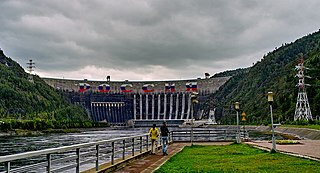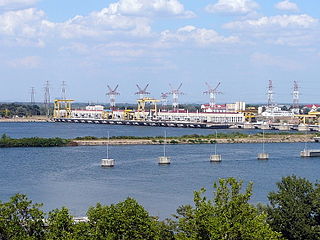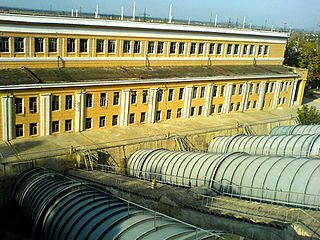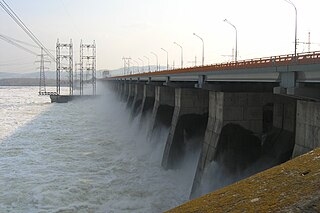
Hydroelectricity, or hydroelectric power, is electricity generated from hydropower. Hydropower supplies one sixth of the world's electricity, almost 4500 TWh in 2020, which is more than all other renewable sources combined and also more than nuclear power. Hydropower can provide large amounts of low-carbon electricity on demand, making it a key element for creating secure and clean electricity supply systems. A hydroelectric power station that has a dam and reservoir is a flexible source, since the amount of electricity produced can be increased or decreased in seconds or minutes in response to varying electricity demand. Once a hydroelectric complex is constructed, it produces no direct waste, and almost always emits considerably less greenhouse gas than fossil fuel-powered energy plants. However, when constructed in lowland rainforest areas, where part of the forest is inundated, substantial amounts of greenhouse gases may be emitted.

The Enguri Dam is a hydroelectric dam on the Enguri River in Tsalenjikha, Georgia. Currently, it is the world's second highest concrete arch dam with a height of 271.5 metres (891 ft). It is located north of the town of Jvari. It is part of the Enguri hydroelectric power station (HES) which is partially located in Abkhazia.
The Hàm Thuận – Đa Mi Hydroelectric Power Complex is a cascade of two hydroelectric power stations in Hàm Thuận Bắc District of the central region of Vietnam. It is operated by Da Nhim – Ham Thuan – Da Mi Hydropower Joint Stock Co., a subsidiary of Vietnam Electricity. The same company also operates the older Đa Nhim Hydroelectric Power Station.

The Sayano-Shushenskaya Dam is located on the Yenisei River, near Sayanogorsk in Khakassia, Russia. It is the largest power plant in Russia and the 9th-largest hydroelectric plant in the world, by average power generation. The full legal name of the power plant, OJSC [Open Joint-Stock Society] P. S. Neporozhny Sayano-Shushenskaya HPP [hydro power plant], refers to the Soviet-time Minister of Energy and Electrification Pyotr Neporozhny. As of 2009 the head of the power plant was Valery Kyari.

The Iron Gate II is a large dam on the Danube River, between Romania and Serbia.
According to the International Hydropower Association, Canada is the fourth largest producer of hydroelectricity in the world in 2021 after the United States, Brazil, and China. In 2014, Canada consumed the equivalent of 85.7 megatonnes worth of oil of hydroelectricity, 9.8% of worldwide hydroelectric consumption. Furthermore, hydroelectricity accounted for 25.7% of Canada's total energy consumption. It is the third-most consumed energy in Canada behind oil and natural gas.
The Turkwel Hydroelectric Power Station, also Turkwel Dam, is an arch dam on the Turkwel River about 76 km (47 mi) north of Kapenguria in West Pokot County, Kenya. The dam serves several purposes to include hydroelectric power production, irrigation tourism and fisheries. It was constructed between 1986 and 1991. It supports the third largest hydroelectric power plant in the country, having an installed electric capacity of 106 megawatts (142,000 hp).
The Kambar-Ata Dam is a proposed dam on the Naryn River in central Kyrgyzstan. One of six planned to be built on the river, it will become one of the largest dams in the world at approximately 275 metres (902 ft) high and containing about 370 million cubic metres of rock and earth. The Kambar-Ati-1 Hydro Power Plant at the base of the dam will have a capacity of around 2,000 megawatts. The project will be constructed jointly with Russia and possibly Kazakhstan as well.

The Samanala Dam is a dam primarily used for hydroelectric power generation in Sri Lanka. Commissioned in 1992, the Samanalawewa Project is the third-largest hydroelectric scheme in the country, producing 405 GWh of energy annually. It was built with financial support from Japan and the United Kingdom. It is notable for a large leak on its right bank. Power production continues as planned despite the leakage, and the water from the leak now provides two thirds of the water issued by the reservoir for agriculture in downstream areas.

The Farkhad Dam is a hydroelectric and irrigation dam on the Spitamen in Sughd Province, Tajikistan. It is a part of the Naryn-Syr Darya Cascade. The dam is located on the territory of Tajikistan and controlled by Tajikistan, while the Farkhad hydropower station, operated by Uzbekenergo.

Sơn La Dam is a concrete gravity dam on the Black River in Ít Ong, Mường La District, Sơn La Province, Vietnam. It is the largest hydroelectric power station in Southeast Asia.
The Stung Treng Dam is a proposed hydroelectric dam on the Mekong River in Stung Treng Province, Cambodia. It would be located on the mainstream of the Lower Mekong River. The project is controversial for several reasons, including its possible impact on the fisheries, as well as other ecological and environmental factors.

Renewable energy in Russia mainly consists of hydroelectric energy. In 2010, the country was the sixth largest producer of renewable energy in the world, although it was 56th when hydroelectric energy was not taken into account. Some 179 TWh of Russia's energy production came from renewable energy sources, out of a total economically feasible potential of 1823 TWh. 16% of Russia's electricity was generated from hydropower, and less than 1% was generated from all other renewable energy sources combined. Roughly 68% of Russia's electricity was generated from thermal power and 16% from nuclear power.

Hydropower is the most used form of renewable energy in Russia, and there is large potential in Russia for more use of hydropower. According to the International Hydropower Association Russia is the seventh largest producer of hydroelectricity in 2020. It is also second in the world for hydro potential, yet only 20% of this potential is developed. Russia is home to 9% of the world's hydro resources, mostly in Siberia and the country's far east. At the end of 2005, the generating capacity from hydroelectric sources in Russia was 45,700 MW, and an additional 5,648 MW was under construction. The World Energy Council believes that Russia has much potential for using its hydro resources, with a theoretical potential of about 2,295 TWh/yr, with 852 TWh being economically feasible.

The Baksan Hydroelectric Power Station is a small hydroelectric power station on the Baksan River in Atazhukino, Baksansky District, Kabardino-Balkaria, Russia. It is one of the oldest hydroelectric plants in Russia. It is owned by RusHydro.
The Trung Sơn Dam is a hydroelectric power station on the Ma River in northwestern Vietnam. Located in the Trung Sơn commune, Quan Hóa District, Thanh Hóa Province, it is approximately 95 kilometres (59 mi) southwest of Hòa Bình city, and 195 kilometres (121 mi) northwest of Thanh Hóa city. The dam created a reservoir which covers a large area of the Mường Lát and Quan Hóa Districts in the Thanh Hoa province as well as part of the Mộc Châu District in Sơn La Province. It is approximately 9.5 kilometres (5.9 mi) from the Vietnam–Laos border. The 260 MW associated power plant became fully operational in September 2017.
The Pangduo Hydro Power Station is a reservoir and dam on the Lhasa River in Lhünzhub County to the east of Lhasa, Tibet Autonomous Region, China. The primary purposes are hydroelectric power generation and agricultural irrigation. Work started in 2008. The first turbine came into production in 2013 and the other three turbines in 2014. With annual generation capacity of 599 million kilowatt hours, it has been called the "Tibetan Three Gorges". Nevertheless, the comparison is hyperbole since the dam is only able to impound less than 1/30th that of Three Gorges.(31.9 vs 0.97 million acre-feet).

The Vorotan Cascade, or the ContourGlobal™ Hydro Cascade, is a cascade on the Vorotan River in Syunik Province, Armenia. It was built to produce hydroelectric power and provide irrigation water. The Vorotan Cascade consists of three hydroelectric power plants and five reservoirs with a combined installed capacity of 404.2 MW. It is one of the main power generation complexes in Armenia.
Daraundi A Hydropower Station is a 6 MW run-of-river hydro-electric plant located on the Daraundi River in the Gorkha District of Nepal.













